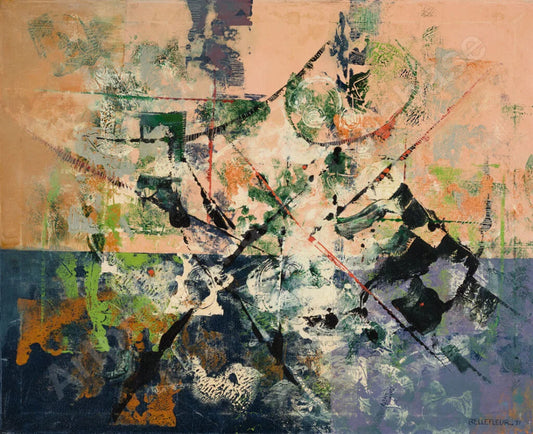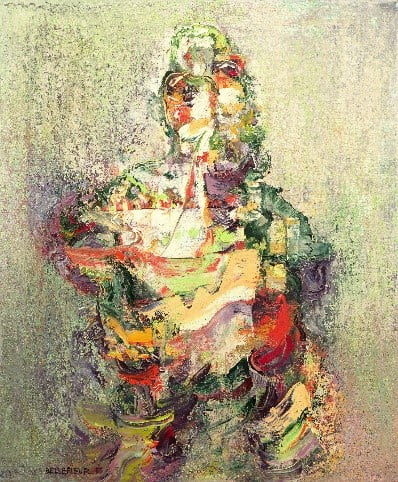Collection: Bellefleur, Leon
-
Léon Bellefleur - Portrait D'ancêtre / Oil/Canvas, 1968, 31 3/4×25 3/4 in // 80.7×65.5 cm
Vendor:Galerie NuancesRegular price $0.00Regular price -

Léon Bellefleur - Le Jongleur aux Rideaux Mauves / Oil/Canvas, 1971, 32 x 39 3/4 in // 81.3 x 101 cm
Vendor:Galerie NuancesRegular price $0.00Regular price
Request for information
Léon Bellefleur, a great contemporary painter
A great Canadian master, contemporary painter Léon Bellefleur, ARC (Royal Canadian Academy) was born in Montreal, Quebec on February 8, 1910 (died February 22, 2007). He graduated from the École normale Jacques Cartier in Montreal in 1929 and taught for 25 years at the Catholic School Commission elementary school in Montreal while attending the École des beaux-arts de Montréal from 1929 to 1938.
A great surrealist painter
The first exhibition of his works took place in 1946. He signed the Prisme d'Yeux manifesto in 1948, directed by Alfred Pellan. In 1951, he won first prize for modern painting at the Salon du Printemps of the Montreal Museum of Fine Arts and in 1953 he joined the Automatist movement. In 1977, he was the first recipient of the Borduas Prize. In 1985, he received the Louis-Philippe Hébert Prize from the Société Saint-Jean-Baptiste and an honorary doctorate from Concordia University in 1987. In 1989, he became a member of the Royal Canadian Academy of Arts.
Léon Bellefleur's works can be found in several public and private collections in Canada, Brazil, England and Denmark.
ADDITIONAL ARTICLE(S):
Leon Bellefleur
[…] Not only did teaching not prevent him from painting, but he also devoted a lot of time to spending time with other artists, notably Alfred Pellan; he was interested in emerging trends and formed his own artistic opinion. In addition, his daily contact with children – he was an elementary school teacher – stimulated his creativity and would subtly and irremediably mark his visual language. Around 1947, he published “Plea for the Child” in the magazine Atelier d’art graphiques. Quebec poetry also occupied an important place in Bellefleur’s world: that of Émile Nelligan, his friend Roland Giguère, Gaston Miron, Gilles Hénault and Paul-Marie Lapointe, to name but a few. He found in poetry a sublimation of life, feelings, and passions. His whole being, and consequently his entire work, would be nourished by these literary, poetic and intellectual encounters. Poetry influences his creativity, but this influence does not translate into visual language as such. Rather, it acts on the artistic inspiration springing from his inner world. After leaving teaching in 1954, Léon Bellefleur left for Paris. There, he made some decisive encounters, including André Breton, with whom he shared a passion for the esoteric. After numerous stays there, he returned permanently to Quebec in the late 1960s.
A period of research, rich in discoveries, then began, during which the artist developed a new approach. While landscape is not a theme directly associated with Bellefleur's work, it nonetheless remains a source of inspiration throughout his artistic journey. His production from the seventies is particularly interesting in this regard. Léon Bellefleur achieved a plastic serenity and artistic maturity, as evidenced by the quality of the works produced. Bellefleur achieved a balance that allowed him to give more space to his poetic universe. The artist ended the seventies with a series of paintings entitled Les volets du temps. The title evokes the passing of the seasons, that of the passing of life in the dance of the cycles of nature, but also his own passing. He was approaching seventy; for him, time operates on matter, it is the revelation of experience, the reward of lucid minds and the awareness of the world.
Source: Robert Bernier, Un siècle de peinture au Québec Nature et paysage, Les Éditions de l’Homme, 1999, Léon Bellefleur, pages 252-253.
Leon Bellefleur (1910)
For Bellefleur, surrealism was first and foremost a gateway to a universe where realities merged into a new vision of the world. He became interested in surrealism in the early 1940s. Painting was a true passion at the time, but family commitments prevented him from devoting himself to it entirely, something he quickly did as soon as he retired from teaching in 1955. If Bellefleur was able to contain his passion for painting until then, it was because his daily contact with children nourished his art in a way as fundamental as his reading and his contacts with other artists. He found in children, while he was a primary school teacher, an essential dimension to his pictorial approach: spontaneity.
This passionate and curious artist drew his inspiration from several sources. In addition to surrealism and children, literature, music, and poetry have profoundly influenced his painting, although their influence is indirect. For Bellefleur, it's the underlying meaning that matters. His working method is the best example of this. He always begins a painting without any preconceived ideas, in an automatist manner.
Then he observes, lets himself be imbued with the first forms and intervenes again, guided by what they suggest to him. His approach gives rise to a revelation, that of the subconscious, as if one were tearing the veil of an imaginary, mysterious and secret world to glimpse a transitional universe between physical and psychic reality.
Léon Bellefleur's work has undergone several phases over the years. His most sought-after works today are from the 1950s. It is nonetheless surprising that the canvases of the 1960s and, even more so, those of the 1970s attract so little attention, considering that he had full mastery of his language at that time. After experimenting with rigorously constructed spaces and fluid ones, the artist achieved a balance: colors and textures spread out accurately in a striking plastic fullness. During the 1980s, the artist led his expression toward a more ethereal dimension where the motif asserts itself. The paintings of the last twenty years remain the least appreciated of his production. A certain repetition is perhaps at the origin of this lack of interest, but the future may reveal these works to us in a different way, unveiling a dimension that would have remained hidden until now.
Source: Robert Bernier, La peinture au Québec depuis les années 1960, Les Éditions de l’Homme, 2002, Bellefleur Léon Bellefleur (1910), pages 21-22.


